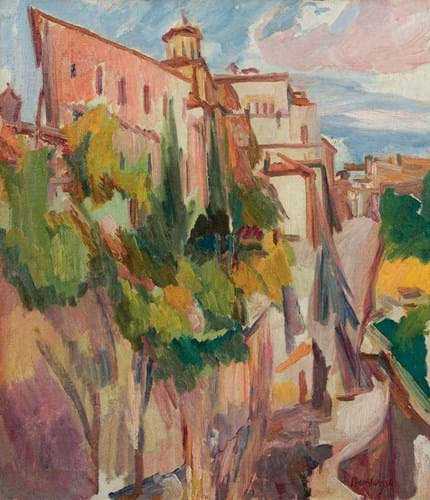While many auction houses might consider this approach for lots at the lower end of the spectrum, it raised a few eyebrows when Dreweatts (26% buyer’s premium) adopted the strategy at a notably higher level of the picture market.
Three works by David Bomberg (1890-1957) that featured at the Newbury saleroom’s Modern and Contemporary art sale on July 11 had previously been unsold in the same rooms in October.
Back then, a group of 14 paintings by the artist came to auction from a single collection with 11 of them selling for a combined £685,600 hammer total (see ATG No 2573).
The works all had provenance to Arthur Abraham Stambois (d.1972), an engineer and one of Bomberg’s main patrons. In 1961, they were sold as a group to Stanley Mann, the husband of the actress and dancer Eithne Maureen Mann (née Milne). After the latter’s death in 2018 they passed to one of her close friends who was the vendor here.
The three works that failed to get away first time round reappeared at the recent sale with much reduced estimates. One was the eye-catching depiction of the historic walled town of Cuenca in Spain, perched high on a limestone spur high above the Huécar gorge.
Showing the garden and tower of the sacristy at Cuenca Cathedral, the 2ft 7in x 2ft 3in (78 x 68cm) oil on canvas was dated 1934. The artist’s colourful Spanish views from the 1930s, particularly those depicting Toledo, Ronda and Cuenca, command a premium at auction. They are deemed to exemplify how the Iberian landscape inspired a new energy and spontaneity in Bomberg’s work.
With examples often making strong six-figure sums, the painting here was pitched at £200,000-300,000 in the October sale. While that range ultimately proved over-ambitious, it was reoffered in July with a revised £80,000-120,000 estimate.
Here the reaction was much better as a mixture of trade and private bidders helped it over this level and it was eventually knocked down at £134,000 to a UK private buyer. This was a decent sum – albeit not the spectacular price that was hoped for first time around.
A view of Ronda that was slightly smaller and with darker tones sold for £30,000 against a £20,000-30,000 estimate. Showing the nocturnal procession during Holy Week where the Virgin of Peace is carried through the streets, it had previously been offered with a £60,000-80,000 pitch. Here again, with expectation levels reduced, it sold to a UK private buyer.
It was a similar story with one of Bomberg’s London scenes. The view of barges on the Thames from 1937 had failed to sell in October against a £20,000-30,000 estimate and reappeared here at £8000-12,000. It got away at £10,000.
While these sums may have been less than was originally expected in October, the auction house and, presumably, the vendor would surely have been pleased with the final outcome with the Bomberg collection totalling a cool £859,600 across the two sales.
Moll in demand
Elsewhere at the Newbury auction, a bright landscape by Austrian artist Carl Moll (1861-1945) drew a strong competition.
Works by Moll, one of the co-founders of the Viennese Secession alongside Josef Hoffman and Gustav Klimt, appear fairly regularly on the market and make a wide range of prices – up to the landmark $4m (£2.86m) for an evocative interior scene at Freeman’s of Philadelphia in 2021 (see ATG No 2482).
A number of decent five-and six-figure sums have been recorded since then and the current lot benefited from a number of factors – not least its attractive brushwork, tonal qualities, distinguished provenance as well as a sense of rediscovery.
Olivenhain, the 19¼ x 23½in (50 x 60cm) oil on canvas which dated from 1931 and was signed with the artist’s monogram, was originally purchased in 1934 by the renowned Swiss collector Oskar Reinhart (1885-1965) from the Gallerie Aktuaryus in Zürich. It had not been on the open market since and was offered here by a descendant.
Although it is mentioned in the artist’s catalogue raisonné (where it is illustrated with a black and white image), its location was unknown until this sale.
It was in fact one of five views of olive groves painted by the artist during the early 1930s depicting locations in Italy and France including Sanary-sur-Mer in Provence which was thought to be the likely subject matter here.
The £20,000-30,000 pitch drew strong interest from the European trade, with a number of dealers competing. It was eventually knocked down at £60,000 to one of them – a solid-looking sum that again made a welcome contribution at Dreweatts.
















